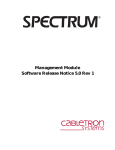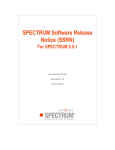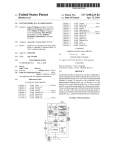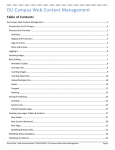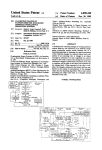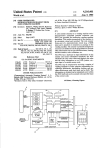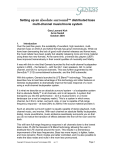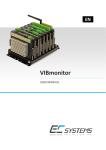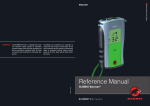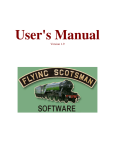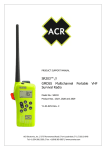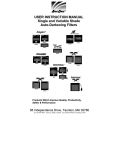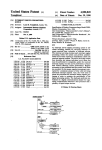Download llllllllllllllllllllllIIII!IllllIlllllllllIlllllllllllllllllllllllIllllllll
Transcript
llllllllllllllllllllllIIII!IllllIlllllllllIlllllllllllllllllllllllIllllllll
US005287103A
United States Patent [191
[11]
[45]
Kasprzyk et al.
[54]
[75]
Primary Examiner-Donald J. Yusko
Assistant Examiner-Brian Zimmerman
Attorney, Agent, or Firm-Michael B. Johannesen
IDENTIFICATION DATA
Inventors: Marlon Z. Kasprzyk, Carol Stream;
Paul K. Wolfe, Jr., Naperville, both
An arrangement providing an internetwork identi?ca
[57]
tion in response to a broadcast message from a LAN
Hill, NJ.
[21] Appl. No.: 814,129
[56]
Filed:
viding a translation of the LAN address to an internet
Dec. 30, 1991
work identi?cation responsive to determining that the
received message is a broadcast message request for
intemetwork identi?cation. The translator comprises a
?rst device for determining that the received message
comprises a broadcast message request for an internet
work identi?cation and a second device coupled to the
Int. Cl.5 ............................... .. H04Q l/00
US. Cl.
...............
. . . ..
Mil/825.52; 370/ 94.1
Field of Search ................ .. IMO/825.52; 370/94.1;
395/200
References Cited
U.S. PATENT DOCUMENTS
4,813,038
3/1989
ABSTRACT
client wherein the broadcast message comprises the
LAN client’s LAN address. The exemplary apparatus
comprises a receiver for receiving a message from the
LAN and a translator coupled to the receiver for pro
[73] Assignee: AT&T Bell Laboratories, Murray
[52]
[58]
Feb. 15, 1994
METHOD AND APPARATUS FOR
PROVIDING LOCAL AREA NETWORK
CLIENTS WITH INTERNETWORK
of I11.
[221
[51]
5,287,103
Patent Number:
Date of Patent:
?rst device and responsive thereto for receiving the
LAN address and providing the internetwork identi?
cation. The second device may comprise a disk system
or other writable, nonvolatile electronic device.
Lee ................................... .. 370/94.l
4,816,826
5,163,045 11/1992
5,166,931
3/1989 Caram
Munter
Riddle .
5,185,860
2/1993
12 Claims, 6 Drawing Sheets
Wu ........ ..
QRO§§ gAMFiis g 15mg
m
{150
FILE
NO
SERVER
'
A164
- —
FIBER
{160
‘
FIBER
I
—
ADDRESS ,— MODEM ‘1(7- MODEM _ ROUTER E
TABLE
162
I
11s
_
|
L
1 OTHER
LANs
US. Patent
Feb. 15, 1994
Sheet 1 of 6
ROS
AMPUS
5,287,103
I NT
COMPUTER C NTER
SYSTEM
FIG. 1
US. Patent
Feb. 15, 1994
1 18
_
Sheet 2 of 6
LOCAL RARP SERVER
5,287,103
_
<_.Z._ _______________ ........._
—
I..." 275
l
|
—
|/()
— {220
{260
CPU
'
LAN
1 10[
{215
RECEIVE
1265
ROM
I
|
CPU
I230 ' '
UNIT
I
'
ROM
I240 I I
,270
RAM
1
RAM
|
I
LAN INTERFACE
210;
"
1 16
-
é
I
ADDRESS
TABLE
c0NTR_0LLER
_
25oI
FIG. 2
_
I
US. Patent
Feb. 15, 1994
Sheet 3 of 6
FIG. 3
300
( POWER-UP )
I
y 302
BOOT SYSTEM
I
{304
SET PARAMETERS FOR
LAN COPROCESSOR &
START RECEIVE UNIT
IS PACKET IN
RECEIVE UNIT
(F|G.4)
,312
ESTABLISH SERIAL
PORT COMMUNICATION
314
IS
SERIAL PORT
ACTTVE
5,287,103
US. Patent
Feb. 15, 1994
Sheet 4 of 6
5,287,103
FIG. 4
I RARP REQUEST I
r
1400
GET PACKET FROM
I
RECEIVE UNIT
IS
MESSAGE TYPE A
RARP
SEND INTERNET
ID TO CLIENT
ISSUE
DIAGNOSTIC MESSAGE
v
RETURN
A
f 404
NO
DISCARD PACKET
US. Patent
Feb. 15, 1994
FIG. 5
Sheet 5 of 6
< PORT ACTIVITY I
II
[500
DISPLAY MAIN
MENU ON SCREEN
GET INPUT LINE
FROM KEYBOARD
REQUEST TO UPDATE
[51D
DISABLE RECEIVE UNIT
I512
DISPLAY ADDRESS
‘
TABLE MAINTENANCE
MENU
[514
GET -
OPERATION REQUEST
FROM KEYBOARD
ADD, CHANGE,
DELETE, OR DISPLAY ‘
ADDRESS TABLE
PER INPUT REQUEST
YES 1520
UPDATE OFFICIAL
ADDRESS TABLE
I
{522
ENABLE RECEIVE UNIT
524
5,287,103
US. Patent
Feb. 15, 1994
‘Sheet 6 of 6
FIG. 6
5,287,103
Q?
;526
E
DISPLAY
NORMAL MODE MENU
SELECT
OPERATION MODE
TYPE
r530
(FIG.4)( RARP REQUEST
\
MONlTOR
PACKET TRAFFIC
IN RECEIVE UNIT
‘
[532
A
SEND
‘
DIAGNOSTIC PACKET
[534
TALK TO ROUTER
r536
EXIT NORMAL MODE
é
‘
1
5,287,103
2
provides internetwork identi?cation data for LAN cli
METHOD AND APPARATUS FOR PROVIDING
LOCAL AREA NETWORK CLIENTS WITH
INTERNETWORK IDENTIFICATION DATA
TECHNICAL FIELD
This invention relates to local area networks (LANs)
and, more speci?cally, to a method and apparatus for
ents. Advantageously, this invention receives a broad
cast message on a LAN, wherein the message comprises
a request for an internetwork identi?cation and the
LAN address of the LAN client, translates the LAN
address into an internetwork identi?cation, and trans
mits a message comprising the internetwork identi?ca
tion to the LAN client.
providing reverse address resolution in a LAN when a
In a method according to the preferred embodiment
10
router is used.
of this invention, a LAN client sends a broadcast mes
BACKGROUND OF THE INVENTION
Local area networks (LANs) are becoming increas
ing sophisticated, with several layers of protocols serv
ing several purposes in routing and administering traf?c
on the LAN. Increasingly, routers are being used to
connect one or more LANs together and to ?le servers,
sage comprising its LAN address on the LAN request
ing an internetwork identi?cation so that it may com
municate with clients on other LANs and one or more
?le servers through a router. A local reverse address
resolution protocol server monitors the LAN for such
requests. The local reverse address resolution protocol
may change or translate the protocol of one LAN to the
server translates the LAN address from the message
into an internetwork identi?cation and transmits a mes
protocol of another as part of its function. By using a
sages comprising the intemetwork identi?cation to the
router, several diverse LANs may be connected to each
other and also share common resources. Routers gener
ally require that, in order to transmit a message from
performing a table look up in an address table where the
printers and other centrally located services. A router
one LAN to another or to the common resources, the
message must have an inter-network identi?cation (In
ternet ID) of the sending or receiving node of the LAN.
One of the characteristics of most routers is that they
do not translate and distribute broadcast messages from
LAN client. Advantageously, the translation comprises
LAN address is paired with its corresponding internet
work identi?cation. Furthermore, if the LAN address is
not in the address table, a diagnostic message is sent to
the LAN client.
'
clients on one LAN to other LANs or to common re
An apparatus according to the preferred embodiment
of this invention provides internetwork identi?cation in
sources. This design evolved because the distribution of
response to a broadcast message from a LAN client
broadcast messages caused severe inter-network con
wherein the broadcast message comprises the LAN
client’s LAN address. The apparatus comprises a re
ceiver for receiving a message from the LAN and a
ever, this design causes an important group of LAN
clients to be cut off from inter-network communications
translator coupled to the receiver for providing a trans
35 lation of the LAN address to an internetwork identi?ca
and central services.
Any LAN client that does not have writable, non
tion responsive to determining that the received mes
volatile memory is cut off from such inter-network
sage is a broadcast message request for internetwork
gestion that results in blocking of other messages. How
communications and services until properly initialized.
identi?cation. Advantageously, the translator com
If a LAN client has a writable, non-volatile store, such
prises a ?rst device for determining that the received
Internet ID information can be stored therein, and will 40 message comprises a broadcast message request for an
be available following any occasion when the LAN
internetwork identi?cation and a second device cou
client is taken out of service and its other memory con
pled to the ?rst device and responsive thereto for re
tents destroyed. As stated above, in order to establish
inter-network communication, a LAN client must have
ceiving the LAN address and providing the internet
work identi?cation (Internet ID) necessary to commu
device is also provided, wherein said updating device
nicate through a router. When such a work station or
comprises a device for sending an update request to a
test system is initially connected to the LAN, or con
?le server and a device responsive to a message from
nected to the LAN following being taken out of service
the ?le server for updating the second device.
an Internet ID. However, work stations that do not 45 work identi?cation. The second device may comprise a
disk system or other writable, nonvolatile electronic
have a disk system and development or test models in
device. Furthermore, the apparatus may include an
systems laboratories frequently do not have writable,
interface for a terminal. A device to update the second
non-volatile memory necessary to store the inter-net
with contents of memory cleared or otherwise de
stroyed, it sends a broadcast message to the ?le server
where Internet IDs are stored, requesting its Internet 55
ID. Since the router does not distribute broadcast mes
sages, the Internet ID request is not delivered to the ?le
server. The solution of providing a ?le server for each
LAN is very expensive and further introduces problems
BRIEF DESCRIPTION OF THE DRAWING
A more complete understanding of the invention may
be obtained from a consideration of the following de
scription in conjunction with the drawings in which
FIG. 1 is a block diagram illustrating the principles of
this invention in the context of a multi-LAN network
employing a router to translate protocols and distribute
messages;
FIG. 2 is a block diagram of a local reverse address
net ID to LAN clients that do not have writable, non
resolution
protocol (RARP) server of FIG. 1 according
volatile memory.
65 to an exemplary embodiment of this invention; and
SUMMARY OF THE INVENTION
FIGS. 3-6 are flow charts for a RARP server accord
ing to FIG. 2 describing the program control of the
This problem is solved and a technical advancement
preferred embodiment of this invention.
is achieved in the art by a method and apparatus that
of concurrently updating all of the ?le servers.
Therefore, a problem in the art is that there is no
inexpensive apparatus and method to provide an Inter
3
5,287,103
DETAILED DESCRIPTION
FIG. 1 shows a simpli?ed block diagram illustrating a
multi-LAN network 100 employing an exemplary em
bodirnent of this invention. Multi-LAN network com
prises LAN 110 and connections to a plurality of other
4
(such as New Jersey) and have a development center in
a second state (such as Illinois). In both of these cases, it
multi-LAN network 100 communicates using the IN
is not possible to have a high quality metallic path con
necting the router and the ?le server. Therefore, ?ber
optics are employed in this embodiment of this inven
tion, but other media may be used, facilities permitting.
LAN 110 comprises, for purposes of this illustrative
embodiment of this invention, a plurality of work sta
TERNET protocol, as is known in the art and fully
described in D. E. Comer, Intemetworking with
tions 111 and a test system 112, as is common in many
development laboratories. Work stations 111 comprise a
LANs, such as 120 and 130. Nodes on each LAN on
TCP/IP, Vol. 1: Principles, Protocols, and Architec
ture, Second Edition, Prentice Hall, 1991. Nodes on
LAN 110 communicate with each other using, for ex
ample, ETHERNET (R) protocol, either version 1 or
version 10 (ETHERNET is a registered trademark of
the Xerox Corporation) as the physical layer protocol
terminal or small personal computer as is known in the
art. Test system 112 comprises a computer, switching
frame or other device that is commonly stored program
controlled. In this exemplary embodiment, test system
112 is down loaded with control software from ?le
server 150, and controlled by one or more of work
in the Open Systems Interconnection (0S1) 7-layer
reference model established by the International Orga
stations 111.
In the prior art when a work station 111 or test sys
tem 112 came onto the LAN, it could communicate
nization for Standardization, Switzerland, and de
scribed in W. Stallings, Data and Computer Communi 20 with work stations 111 and test system 112, but could
not communicate with LANs 120 and 130, or with ?le
cations, Third Edition, Macmillan Publishing Com‘
server 150, because it did not know its Internet ID.
pany, 1991. LAN 120 uses, for purposes of this illustra
Work stations 111 and test system 112 do not have
tion, STARLAN10 as is known in the art and described
storage facilities that are protected from power shut
in AT&T Starlan Network, Hardware Technical Refer
down, sometimes call “diskless systems.” In order to
ence, Issue 01, Select Code: 999-120-201, available from
obtain an Internet ID, work stations 111 and test system
AT&T. LAN 130 may be, for example, another
112 must send a message to ?le server 150, containing an
ETHERNET LAN. The intra-network protocols used
address. File server 150 maintains an address table 116
here are for illustrative purposes only, as this invention
with a translation of address to Internet ID. Since work
may be used with any physical layer LAN protocol.
stations 111 and test system 112 do not know the ad
All of the LANs are connected to a router 140.
dress of the ?le server, they must send broadcast mes
Router 140 receives all messages on all of the LANs
sages on the network requesting their Internet ID.
connected to it and recognizes messages that are to be
Routers such as router 140 are traditionally built so
forwarded to another LAN. Router 140 translates the
that messages are routed with maximum ef?ciency and
message protocol from the source LAN to the destina
a minimum of congestion. Since broadcast messages
tion LAN, and transmits the message on the destination
LAN. Routers such as router 140 are known in the art.
cause congestion, routers such as router 140 do not pass
In this exemplary embodiment, router 140 is manufac
tured by‘ Proteon Inc., Two Technology Drive, West
borough, Mass, and described in Proteon Model p4200
Hardware Installation Manual, No: 42-040182-00, De
cember, 1989. Additionally, router 140 accepts mes
on broadcast messages, because broadcast messages
sages from all LANs destined for a common ?le server
150.
File server 150 is usually a main frame or large mini
have to be sent to all LANs as well as to ?le server 150.
Therefore, all “diskless systems” on a LAN cannot
40 communicate from the home LAN 110 to another LAN
or to the ?le server without going through the router to
obtain an Internet ID from the ?le server, but the router
will not forward broadcast messages.
To solve this problem, a local RARP server 115 is
computer, as is known in the art. File server 150 pro 45 used according to the principles of this invention. The
local RARP server (LRS) listens to the network for
vides mass storage and other resources for all of the
broadcast messages of one or more speci?c types, trans
LANs connected to router 140. File server 150 may also
have print spooler and other functions that may be
lates the address into an Internet ID, and responds to
required by the LANs. Router 140 translates a message
received for ?le server 150 into the proper protocol and
sends the message to ?ber optic modern 160, in this
the requester. In the preferred embodiment, local
preferred embodiment. Fiber optic modern 160 trans
includes, in the preferred embodiment, a terminal 117
for updating address table 116 and controlling such
functions as monitoring packet transfer and diagnostics.
mits the message via ?ber optic links 162 to a second
?ber optic modern 164. Second ?ber optic modem 164
communicates with ?le server 150. File server 150 re
sponds to the request by sending a message back to the
requester via ?ber optic modem 164, ?ber optic links
RARP server 115 includes a copy of the address table
116 as kept in ?le server 150. Local RARP server 115
Additionally, an optional connection 118 may connect
local RARP server 115 to router 140, and local RARP
server 115 may control, initialize, etc. router 140.
In this exemplary embodiment, when test system 112
is powered up or otherwise initialized, as part of the
162 and ?ber optic modem 160 to router 140. Router
140 translates the response to the proper protocol, and
sends the message on the appropriate LAN.
boot function it will send a broadcast message on LAN
It is increasingly common to have a ?le server lo
cated in a computer center or facility remote from the
one or more of the LANs it serves. For example, a
110 requesting its Internet ID. Local RARP server 115
monitors LAN 110, receives the message and deter
mines that the message is a broadcast message. Local
research and development facility may have a complex
RARP server 115 next uses the address of the device
comprising several buildings. One or more of the build 65 from the broadcast message and performs a table look
up to determine the Internet ID for the received ad
ings may be physically located remotely from the com
dress. Local RARP server 115 formats and sends a
puter center where the ?le server is located. Also, it is
message to the requester including the Internet ID. The
increasingly common to have a ?le server in a ?rst state
5
5,287,103
requester, in this case, test system 112, may then com
municate with ?le server 150 or LANs 120 and/or 130.
FIG. 2 is a block diagram illustrating the main com
ponents of Local RARP server 115. Local RARP
server 115 is, in this exemplary embodiment, divided
into a LAN interface 210 and a controller 250. LAN
interface 210 provides the physical connection to LAN
110 and receives all messages sent on LAN 110 at re
ceive unit 215. Receive unit 215 is under the control of
CPU 220 and noti?es CPU 220 of any incoming mes
sage packets of a speci?c type. In this preferred embodi
ment, receive unit 215 noti?es CPU 220 of the receipt of
messages of type RARP.
CPU 220 is a dedicated LAN interface CPU, which is
Intel 82586, available from the Intel Corp., Beaverton,
Greg, and described in Local Area Networking (LAN)
Component User’s Manual, Order Number: 230814-004,
6
tion. The local RARP server of this invention is initial
ized upon power-up. Therefore, processing starts in
balloon 300 with power-up. Processing continues to box
302 where the system boots via ROM 265 (FIG. 2) or
alternatively pumped from a card download system as is
known in the art. Processing continues to box 304
where the parameters for the LAN interface 210 (CPU
220 FIG. 2) are set and the receive unit 215 (FIG. 2) is
started.
Processing continues to a large loop that remains
active until the power is turned off. Processing contin
ues to decision diamond 306 which represents a power
off. If the power goes off, processing terminates at bal
loon 308. If the power is on, then processing continues
to decision diamond 310 where a test is made if the
receive unit has received a packet. If the receive unit
has received a packet, then processing continues to the
process packet subroutine (FIG. 4). When the process
in the preferred embodiment. CPU 220 is a processor,
packet subroutine returns, processing loops to the test
under control of a program stored in ROM 230. CPU
for power decision diamond 306.
220 causes message packets of type RARP to be moved
If there were no packets in the receive unit memory
from receive unit 215 into RAM 240. CPU 220 then
in decision diamond 310, then processing continues to
causes the message packets to be moved from RAM 240
box 312, where communication is established with the
into controller 250.
IO port 275 (FIG. 2). A determination is made in deci
Controller 250 reads the header of the RARP mes
sage, searching for the ?eld which contains the address 25 sion diamond 314 whether the serial port is active. If the
serial port is not active, processing loops to decision
of the device requesting its Internet ID. Controller 250
diamond 306. If, in decision diamond 314, the serial port
is under control of CPU 260, which is a standard micro
is active, then processing continues to the process serial
processor in the preferred embodiment. CPU 260 is a
port subroutine (FIG. 5). When the process serial port
processor, under control of a program stored in ROM
subroutine returns, processing loops back to decision
265. Message packets are received in controller 250 at
diamond 306.
'
RAM 270 after being transferred from RAM 240 of
Turning now to FIG. 4, the process packet subrou
LAN interface 210 via direct memory access, as is
tine is shown. Processing starts in box 400 where the
known in the art, under control of CPU 220. CPU 260
packet is moved from receive unit 215 (FIG. 2) to mem
?nds the address in RAM 270, and performs a data base
35 ory through LAN interface RAM 240 and into control
look up in address table 116.
ler RAM 270 (FIG. 2). The receive unit memory is then
Address table 116, in the preferred embodiment, com
freed. Processing continues to decision diamond 402
prises a 1.44 megabit “floppy” disk system, as is known
where a test is made of the message type. If the message
in the art. Alternatively, address table 116 may com
type is not a RARP type, then the message is not a
prise a large “hard" disk system, EEPROM, PROM, or
some other form of occasionally writable, non-volatile 40 broadcast message requesting a reverse address transla
tion. Processing thus continues to box 404 where the
memory. Address table 116 may be updated by simply
packet is discarded. Processing then continues to bal
removing the disk and adding or deleting addresses, or
loon 406 where the subroutine returns.
may be updated by a program running on CPU 260,
If in decision diamond 402 the message is of type
which displays address-Internet ID pairs, and allows
the user to add, change, and delete such pairs. Address 45 RARP, then processing continues to decision diamond
408 where a test is made if the address found in the
table 116 may, for more sophisticated system, be up
message is in the address table. In a normal case, the
dated by requesting a new copy of the address table
address will be found in the address table and the Inter
from the ?le server.
net ID is sent to the client in box 410. Processing then
Upon determining the Internet ID, CPU 260 formats
returns at balloon 406.
a return message packet for the device requesting its
If in decision diamond 408 the address was not in the
Internet ID in RAM 270. CPU 260 then noti?es CPU
address table, then processing continues to box 412
220, and CPU 220 causes the message packet to be
where a diagnostic message is issued. The diagnostic
moved into RAM 240 via direct memory access. CPU
message is, in the preferred embodiment, a message sent
220 then causes the message packet to be moved into
through the IO port 275 to the control terminal 117.
receive unit 215, which send the message packet out on
However, the diagnostic message may be sent to the
LAN 110.
address found in the message packet indicating a failure
Controller 250 also comprises in the preferred em
or a message may be sent via LAN 110 to ?le server
bodiment an I/O controller 275, as is known in the art,
150, and the failure logged. Processing then proceeds to
for coordinating serial I/O with devices other than
LAN 110. In this embodiment, I/O port 119 in I/O 275 60 the return balloon 406.
is connected to a terminal 117 for controlling controller
250. Additionally, one I/O port 118 of I/O 275 is op
FIG. 5 shows the service serial port subroutine. Ser
vice serial port subroutine is directed towards control of
tionally connected to router 140, for remotely control
ling router 140. Any of the I/O ports of I/O 275 may be
ever, it would also be possible for the subroutine to
a terminal such as terminal 117 (FIGS. 1 and 2). How
connected to additional LANs, or other serial devices, 65 control the router or accept local area network input, as
is known in the art. Processing starts at at box 500
as is known in the art.
where the main menu is displayed on the screen. Pro
FIG. 3 is a flow chart showing the control of CPU
cessing continues to decision diamond 502 where a test
260 (FIG. 2) of the preferred embodiment of this inven
5,287,103
7
8
is made for serial input from a keyboard. If there is no
copy of the address table may be requested from the ?le
serial input from the keyboard, then processing returns
server. If the Internet ID is still not found in the new
copy of the address table, then the local RARP server
could log the failed request to the ?le server. It is, there
fore, intended that such variations be included within
the scope of the claims.
We claim:
1. A method for providing an intemetwork identi?ca
in balloon 504.
_
If in decision diamond 502 there is serial input from a
keyboard, then processing continues to box 506 where
an input line is retrieved from the keyboard. Processing
continues to decision diamond 508 where a test is made
if the input request is to update the address table. If the
input is not to update the table, then processing pro
tion to a client on a local area network (LAN), said
10 LAN client comprising a node on said LAN that does
ceeds to connector A (FIG. 6).
If in decision diamond 508 input request is to update
the table, then processing continues to box 510 where
receive unit 215 (FIG. 2) is disabled. The receive unit is
disabled so that no partial Internet IDs are delivered to
clients on the LAN, and so that the proper Internet ID
is delivered in all cases. Processing continues to box 512
where the address table maintenance menu is displayed.
Processing continues to box 514 where the operation
request is obtained from the keyboard. Processing con
tinues to decision diamond 516 where a test is made if
the keyboard input is a request to exit. If it is not, then
processing continues to box 518 where the address table
116 (FIG. 2) is updated with additions, changes, dele
tions, or a display of the address table entries is per
formed. Processing continues from box 518 back to box
512 where the address table maintenance menu is dis
played.
If in decision diamond 516 that the input from the
keyboard was determined to be a request to exit, then
processing continues to box 520 where address table 116
(FIG. 2) is updated. Processing then continues to box
522 where receive unit 215 (FIG. 2) is enabled so that
Internet IDs may be obtained and processing returns in
balloon 524.
Turning now to FIG. 6, if in decision diamond 508
the input is determined not to be a request to update the
address table, then processing proceeds through con
nector A to box 526 where the normal mode menu is
displayed. Processing continues to decision diamond
528 where input is retrieved from the keyboard and the 40
operation mode is selected. Processing may continue in
box 530 where all packets coming into the receive unit
not have a writable, non-volatile memory for storing
said intemetwork identi?cation, said LAN being con
nected to other LANs by a router, said router being
con?gured to not pass broadcast messages from said
LAN to said other LANs, said method comprising:
receiving on said LAN a broadcast message from said
LAN client during initialization of said LAN cli
ent, said broadcast message requesting an intemet
work identi?cation for use in subsequent communi
cation with nodes on said other LANs and specify
ing an address of said LAN client;
translating said address of said LAN client into said
intemetwork identi?cation; and
transmitting a message on said LAN to said LAN
client containing said intemetwork identi?cation,
whereby said intemetwork identi?cation of said
LAN client is obtained without said router passing
said broadcast message to other LANs.
2. A method in accordance with claim 1 wherein said
translating comprises performing a table look up in an
address table where said LAN address is paired with its
corresponding intemetwork identi?cation.
3. A method in accordance with claim 2 further com
prising:
if said LAN address is not paired with a correspond
ing intemetwork identification in said address ta.
ble, transmitting a diagnostic message to said LAN
client.
4. A method in accordance with claim 2 further com
prising:
if said LAN address is not paired with a correspond
ing intemetwork identi?cation in said address ta
are monitored. This informs the maintenance person of
ble, transmitting a request to a tile server for an
the packet traf?c on local area network 110. Alterna
update of said address table.
tively, in box 532 a diagnostic packet may be sent across 45
5. An apparatus for use in a LAN, said LAN compris
LAN 110 to determine the functionality of both the
ing one or more clients that do not have writable, non
LAN and the local RARP server. Also, in box 534,
volatile memory for storing an intemetwork identi?ca
communication may be established through I0 275
tion, said client relying on a node on one other LAN for
data storage, said LAN being connected by a router to
(FIG. 2) to router 140 (FIG. 1). After each step in this
process, processing continues through connector A
where packets are checked for RARP requests. This
gets high priority to handling of packets, which is the
primary functionality of the local RARP server. Pro
cessing then returns back to box 526.
Also, as a result of the select operation mode type
decision diamond 528, a selection would be made to exit
the normal mode in box 536. In this case, processing
continues to the return balloon 524.
It is to be understood that the above-described em
bodiment is merely an illustrative principle of the inven
tion and that many variations may be devised by those
skilled in the art, without departing from the scope of
the invention. For example, local RARP server could
other LANs, including said one other LAN, said router
being con?gured to not pass broadcast messages from
said LAN to said other LANs, said apparatus providing
an intemetwork identi?cation in response to a broadcast
message request for intemetwork identi?cation at ini
tialization of one of said client, said broadcast message
including said one client's address, said apparatus com
prising:
means for receiving said broadcast message from said
LAN; and
means, coupled to said means for receiving, for pro
viding a translation of said address of said one
client to an intemetwork identi?cation responsive
to determining that said received message is a
be used to monitor for unauthorized access to a local
broadcast message request for intemetwork identi
?cation.
area network. Local RARP server could also be used as 65
a monitor for counting and reporting on unusual mes
6. An apparatus in accordance with claim 5 wherein
sage types being distributed on LAN 110. Additionally,
said translation means comprises ?rst means for deter
if the Internet ID is not found in the address table, a new
mining that said received message comprises a broad
5,287,103
wherein said updating means comprises
means for sending an update request to a ?le server,
and
means responsive to a message from said ?le server
responsive to said request by said ?rst means for provid
ing said internetwork identi?cation.
for updating said second means.
12. On a LAN,
a terminal without storage of an internetwork identi
7. An apparatus in accordance with claim 6 wherein
said second means comprises a disk system.
8. An apparatus in accordance with claim 6 wherein
said second means comprises a writable, nonvolatile
electronic device.
9. An apparatus in accordance with claim 6 further
comprising
means for interfacing said ?rst means to a terminal.
10
11. An apparatus in accordance with claim 10
cast message request for an internetwork identi?cation,
and second means for receiving said address and pro
viding said internetwork identi?cation, said ?rst means
coupled to said second means and said second means
?cation necessary to permit communication to and
from it outside said LAN;
storing means on said LAN for storing said internet
15
10. An apparatus in accordance with claim 6 further
comprising
work identi?cation unique to said terminal; and
translating means for monitoring broadcast messages
on said LAN from said terminal and for responding
to selected broadcast messages from said terminal
by delivering a message to said terminal compris
ing said internetwork identi?cation from said stor
age means.
means for updating said second means.
a:
25
35
45
50
55
65
a
a
a
a












